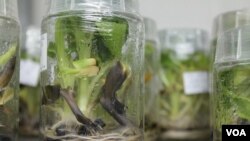The worldwide banana crop is under serious threat as a deadly fungus has rampaged its way through banana farms, landing recently in Africa.
The latest carnage has been seen in Mozambique, which recently reported a new outbreak of the deadly TR4 strain of Panama Disease.
This is not just an agricultural threat, but an economic one: Officials in Mozambique say the crop brings in more than $70 million per year.
Eldad Karamura is a senior scientist responsible for regional banana research for research organization Bioversity International, and is based in Kampala, Uganda. He says this deadly strain was first seen in Mozambique about two years ago and recently resurfaced on two farms. The government has tried to impose a quarantine to confine the disease.
But Prof. Altus Viljoen, from the Department of Plant Pathology at Stellenbosch University in South Africa — whose team first spotted the problem — says he is worried about that farm in northern Mozambique. The fungus has spread more rapidly than expected, helped by recent floods.
“I’ve never seen it developing as quickly as it has in Mozambique, on that farm,” he told VOA News. “It’s just become an enormous problem in the past year — the number of plants affected increased from 1 percent to almost 20 percent of plants affected on that farm.”
#YESALLBANANAS
Why is this so serious? For the answer, you have to look into the little-known history of the modern banana. Most commercially available bananas are of the Cavendish cultivar — your garden-variety yellow banana, seen on breakfast buffets and produce aisles of major supermarkets around the world. The Cavendish was actually introduced in the 1950s — and at the eleventh hour, at that — after the previous top banana, the Gros Michel, was obliterated by a strain of Panama Disease.
But since commercially grown bananas are propagated non-sexually, every Cavendish banana in one plant is a clone of every other Cavendish banana in that plant. That means they can’t evolve to evade diseases — and with the TR4 strain, for which there is no effective treatment, they’ve met their match.
Karamura says there is no new cultivar waiting in the wings to replace the Cavendish, but that’s not for lack of trying. Banana scientists, he says, just haven’t yet chanced upon a lucky candidate.
Not quite ready to split?
But Viljoen says not all is lost. The Cavendish’s savior may turn out to be … another strain of the Cavendish, a mutant developed in Taiwan.
“They tolerate the TR4 quite well,” he said. “The problem is, they tolerate the tropical area quite well, but if you introduce them into other areas, they don’t do quite as well.”
But, he added, “Mozambique has no other choice right now, because the epidemic has become very, very severe. So if they don’t use these plants, there’s no hope for saving that plantation. So they have to go to the Taiwanese.”
Gert Kema is a researcher at the Netherlands’ Wageningen University, and one of his research specialties is bananas. He spoke to VOA News from the Philippines.
He says that with this latest outbreak, he’s worried about more than just the Cavendish.
“The problem with Tropical Race 4 also is that it affects many, many other local varieties,” he said. “And that’s why the incursion in Mozambique is so dramatic. Because it’s not only that this is the first appearance of TR4 in Africa, which is really bad, and to put it very boldly, I blame the industry for that. They should know that this is very risky, and yet, they are the guys who bring it into that continent.”
Viljoen is more optimistic.
“Our initial tests have shown that the African cooking banana has some resistance [to TR4],” he said.
In Africa, the banana is tops
But bananas also play a huge role in African society, Karamura says. The average Ugandan actually eats more bananas than anyone in the world, and some Ugandans eat up to 400 kilograms of banana — each — every year.
He is one of them.
“I was born and bred on bananas,” he said, laughing. “I grow bananas myself. Every African family must have a banana. It is just said in my country that a man should have a banana plantation and a house. So it’s part and parcel of growing up, if you can’t have bananas you probably will not be able to marry as a young man, because it is part of the bride price. It’s part of the cultural system.”
The humble banana may soon be toast, these scientists say, because of this epidemic. It is, in a word … worrying.





